The Acrylic Polymer Market is estimated to be valued at USD 722.0 million in 2025 and is projected to reach USD 1256.9 million by 2035, registering a compound annual growth rate (CAGR) of 5.6% over the forecast period.
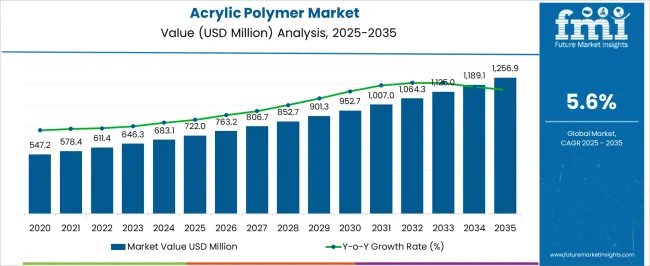
| Metric | Value |
|---|---|
| Acrylic Polymer Market Estimated Value in (2025 E) | USD 722.0 million |
| Acrylic Polymer Market Forecast Value in (2035 F) | USD 1256.9 million |
| Forecast CAGR (2025 to 2035) | 5.6% |
The acrylic polymer market is experiencing strong growth, driven by expanding demand in construction, automotive, and packaging industries. Superior weather resistance, optical clarity, and versatility in applications have positioned acrylic polymers as a preferred material for coatings, adhesives, and plastics. Current growth is supported by infrastructure development, increasing demand for sustainable and low-VOC materials, and innovations in high-performance formulations.
Water-borne solutions are gaining traction as regulatory standards tighten, pushing industries toward environmentally compliant alternatives. In addition, rising adoption in paints and coatings highlights the material’s role in delivering durability and aesthetic performance across diverse substrates.
Market expansion is anticipated as advancements in polymer chemistry enhance functionality while aligning with global sustainability targets. Overall, the acrylic polymer market is projected to maintain steady growth as industries continue to seek lightweight, durable, and eco-friendly material solutions.
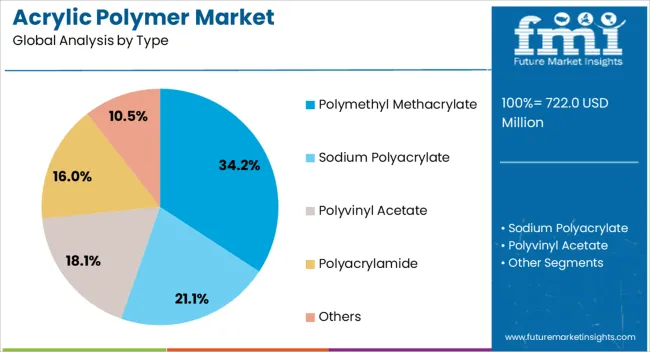
The polymethyl methacrylate (PMMA) segment accounts for approximately 34.20% of the type category in the acrylic polymer market. Its dominance is attributed to excellent optical clarity, scratch resistance, and weatherability, which make it indispensable in automotive components, electronics displays, and construction glazing.
PMMA’s lightweight nature and shatter resistance have reinforced its role as a substitute for glass in multiple applications, adding to its widespread adoption. Demand has been further supported by innovations in extrusion and molding technologies that enhance design flexibility.
While alternative polymers exist, PMMA’s performance balance continues to drive preference across industries. With ongoing investments in automotive lightweighting and energy-efficient buildings, the segment is expected to maintain a strong position in the coming years.
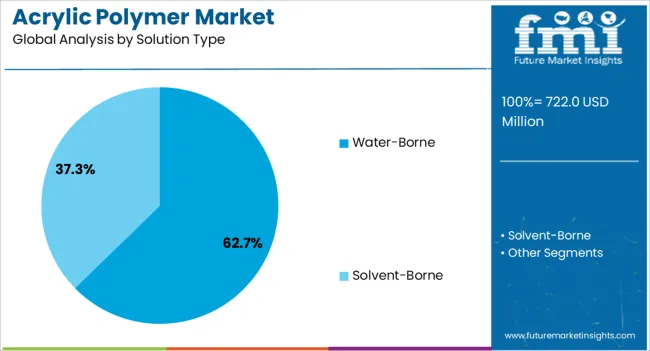
The water-borne segment leads the solution type category with approximately 62.70% share, driven by increasing environmental regulations favoring low-VOC and solvent-free formulations. Water-borne acrylic polymers are widely used in architectural coatings, adhesives, and textile finishing due to their excellent adhesion, flexibility, and ease of application.
Adoption has been accelerated by their ability to deliver comparable performance to solvent-based alternatives while reducing health and environmental risks. Market players are investing in enhancing durability and resistance properties, further boosting applicability across high-performance coatings.
With governments enforcing stricter emission standards and industries shifting toward green chemistry, the water-borne segment is projected to retain its leadership.
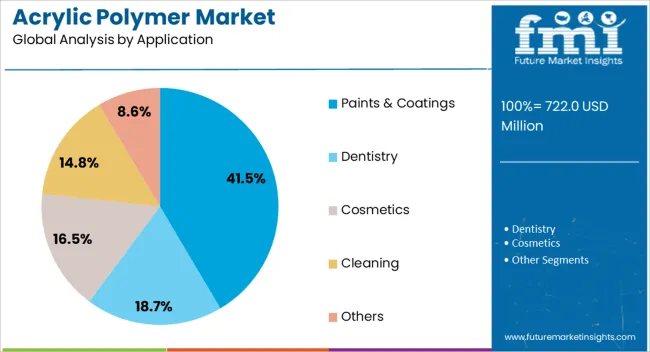
The paints and coatings segment dominates the application category with approximately 41.50% share, reflecting the heavy reliance on acrylic polymers in surface protection and decorative finishes. Acrylic-based coatings offer superior gloss retention, weather resistance, and color stability, making them essential in both architectural and industrial markets.
The segment has gained momentum with rising construction activity and automotive refinishing demand, where durability and aesthetics are equally critical. In addition, sustainability trends have accelerated the adoption of acrylic formulations in water-borne and powder coatings.
With infrastructure investments and consumer preference for long-lasting finishes, the paints and coatings segment is expected to sustain its leadership in the foreseeable future.
The market size of acrylic polymer was marked to be USD 547.2 million in 2020. The market progressed consistently over the historical period from 2020 to 2025, with a CAGR of 2.7%.
The acrylic polymer market has experienced steady growth, driven by its versatile properties and widespread use in various industries.
Technological advancements and the development of high-performance acrylic polymers with enhanced characteristics have also played a critical role in expanding the market.
Initially, supply chain and production disruptions were observed. However, the market rebounded as demand surged in various sectors, such as healthcare for medical equipment and paints, as people invested in home improvements and packaging materials.
The increased focus on hygiene and the resilient nature of acrylic polymers contributed to the market's recovery after pandemic-related challenges.
| Attributes | Details |
|---|---|
| Market Value (2020) | USD 501.0 million |
| Historical CAGR (2020 to 2025) | 6.4 % |
| Historical Market Valuation (2025) | USD 642.6 million |
Based on solution type, the market is segmented into polymethyl methacrylate and water-borne. Solution types in the acrylic polymer market are crucial as they provide versatile and easily applicable formulations for industries. Solutions offer efficient coating, adhesion, and flexibility, meeting diverse application needs across sectors.
Polymethyl methacrylate is the common type of acrylic polymer used. From 2025 to 2035, polymethyl methacrylate is expected to account for a CAGR of 5.7% of the market share.
Polymethyl methacrylate (PMMA) is a highly versatile acrylic polymer widely used across various industries. Its exceptional optical clarity and transparency, which makes it a popular choice for applications such as clear plastics, optical lenses, and light-transmitting materials, are among its key advantages.
PMMA's ability to transmit light efficiently while being durable and weather-resistant makes it a preferred material for producing signage, displays, and lighting fixtures.
| Attributes | Details |
|---|---|
| Top Type | Polymethyl Methacrylate |
| CAGR (2025 to 2035) | 5.7% |
Water-borne solutions have become the preferred choice in the acrylic polymer industry due to their eco-friendliness and sustainability. For the forecast period, the water-borne segment is anticipated to contribute a CAGR of 5.6% of the market share.
Water-borne acrylic polymers are increasingly preferred in the industry due to their eco-friendliness. They have lower VOC levels than solvent-based alternatives, making them compliant with environmental regulations. They offer advantages such as ease of application, faster drying times, and reduced odor.
| Attributes | Details |
|---|---|
| Top Solution Type | Water-Borne |
| CAGR (2025 to 2035) | 5.6% |
The demand for eco-friendly acrylic polymer solutions is rapidly increasing. Manufacturers in the United States, the United Kingdom, China, Japan, and South Korea invest in research and development to meet the growing demand for waterproof construction chemicals.
Regulatory pressures and consumer preferences for sustainable and safer materials drive this trend.
| Countries | CAGR (2025 to 2035) |
|---|---|
| United States | 6.1% |
| United Kingdom | 6.5% |
| China | 6.3% |
| Japan | 7.4% |
| South Korea | 7.2% |
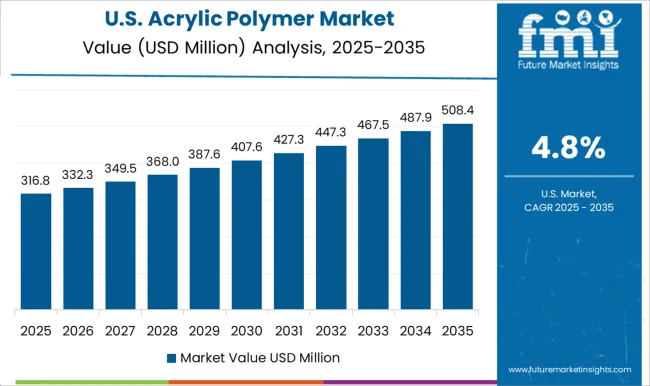
The United States is set to be one of the lucrative countries for the market. For the 2025 to 2035 period, the market is estimated to register a normal growth of 6.1%.
The construction industry in the United States is experiencing a significant boom, driving the demand for acrylic polymers in various applications, including coatings, sealants, and adhesives.
The market's growth in the United States is also attributed to ongoing research and innovation in acrylic polymer technology, focusing on developing sustainable solutions.
For instance, in a paper published on February 14, 2025, researchers showcased the antibacterial and anti-biofouling qualities of sub-100-nanometer scale nanopatterned polymers in acrylic nanostructured films designed for food packaging applications.
The acrylic sheets mark the parameters and push the boundaries of construction in the United Kingdom acrylic polymer industry. For the forecast period, the CAGR for the United Kingdom is predicted to be 6.5%.
The United Kingdom has seen a surge in demand for acrylic polymer-based paints, coatings, and adhesives due to an increased focus on architectural renovations and home improvements.
The country's strict environmental regulations have also contributed to adopting water-borne acrylic polymer solutions, which align with the country’s sustainability goals.
Another country in Asia marked with promise for the market is China. For the forecast period, the CAGR for China is predicted to be a commendable 6.3%.
China's rapid urbanization has significantly increased construction activity, resulting in a high demand for acrylic polymers in various construction materials and coatings.
Being a leading manufacturing hub, China's industrial sector is a key consumer of acrylic polymers in diverse applications ranging from textiles to consumer goods.
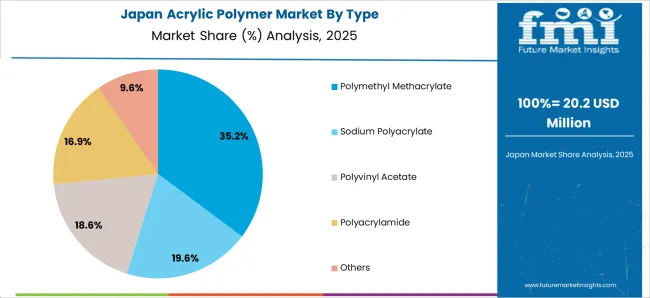
The innovative automotive industry requires acrylic polymers for lightweight and durable materials used in paints, coatings, and interior components. With a technology-driven market, Japan is constantly advancing its acrylic polymer formulations to meet the evolving needs of various industries.
The market for acrylic polymers in Japan is predicted to be a commendable 7.4% for the forecast period.
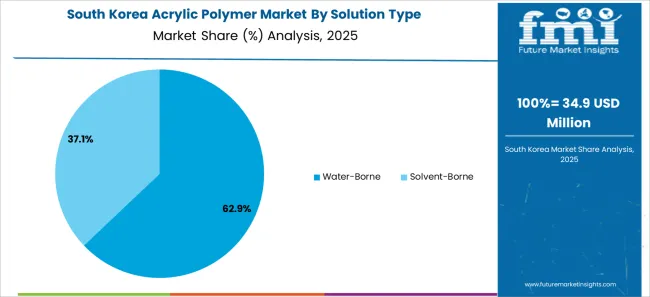
South Korea's robust electronics manufacturing sector relies heavily on acrylic polymers to produce electronic components, coatings, and adhesives.
As a key player in the petrochemical industry, South Korea benefits from a strong supply chain and advanced manufacturing capabilities supporting its acrylic polymer market. For the forecast period, the demand for acrylic polymers in South Korea is predicted to be a commendable 7.2%.
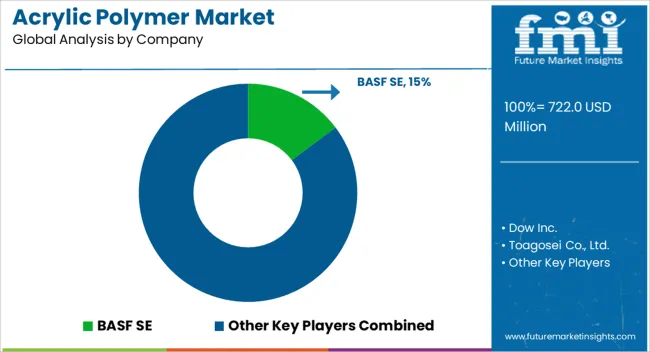
Companies in the acrylic polymer industry should focus on strategic initiatives to stay competitive and capitalize on market trends.
They are moreover, investing in research and development to develop advanced acrylic polymer formulations that align with emerging industry needs, such as environmentally friendly solutions, enhanced product performance, and exploring new applications to diversify their product portfolios.
In addition, establishing strong partnerships and collaborations across the value chain can enhance market reach and ensure a stable supply chain. Focusing on compliance with evolving environmental regulations is also essential for long-term success.
Recent Development
On February 9, 2025, a Germany-based chemical company, Roehm launched two acrylic-based copolymer compounds, Cyrolite GP-20 and MD zk6, at the 2025 MD&M West trade show. Engineered for injection molding and extrusion, these compounds showcased an exceptional balance of properties ideal for medical devices.
The global acrylic polymer market is estimated to be valued at USD 722.0 million in 2025.
The market size for the acrylic polymer market is projected to reach USD 1,256.9 million by 2035.
The acrylic polymer market is expected to grow at a 5.6% CAGR between 2025 and 2035.
The key product types in acrylic polymer market are polymethyl methacrylate, sodium polyacrylate, polyvinyl acetate, polyacrylamide and others.
In terms of solution type, water-borne segment to command 62.7% share in the acrylic polymer market in 2025.






Full Research Suite comprises of:
Market outlook & trends analysis
Interviews & case studies
Strategic recommendations
Vendor profiles & capabilities analysis
5-year forecasts
8 regions and 60+ country-level data splits
Market segment data splits
12 months of continuous data updates
DELIVERED AS:
PDF EXCEL ONLINE
Styrene Acrylic Emulsion Polymers Market Size and Share Forecast Outlook 2025 to 2035
Homopolymer Acrylic Filter Bags Market Size and Share Forecast Outlook 2025 to 2035
Acrylic Paint Market Forecast and Outlook 2025 to 2035
Acrylic Fibre Market Size and Share Forecast Outlook 2025 to 2035
Acrylic Emulsions Market Size and Share Forecast Outlook 2025 to 2035
Acrylic Resin Market Size and Share Forecast Outlook 2025 to 2035
Acrylic Fine Particle Market Size and Share Forecast Outlook 2025 to 2035
Acrylic Boxes Market Size and Share Forecast Outlook 2025 to 2035
Acrylic Paper Market Size and Share Forecast Outlook 2025 to 2035
Acrylic Pad Market Size and Share Forecast Outlook 2025 to 2035
Acrylic Adhesives Market Growth - Trends & Forecast 2025 to 2035
Acrylic Teeth Market Trends and Assessment for 2025 to 2035
Acrylic Styrene Acrylonitrile (ASA) Resin Market- Growth & Demand 2025 to 2035
Key Companies & Market Share in the Acrylic Airless Bottle Sector
Analyzing Acrylic Boxes Market Share & Industry Leaders
Acrylic Acid Market Growth - Trends & Forecast 2024 to 2034
Acrylic Airless Bottle Market Trends - Demand & Forecast 2024 to 2034
Acrylic Colors Market
Acrylic Container Market
Acrylic Lenses Market

Thank you!
You will receive an email from our Business Development Manager. Please be sure to check your SPAM/JUNK folder too.
Chat With
MaRIA